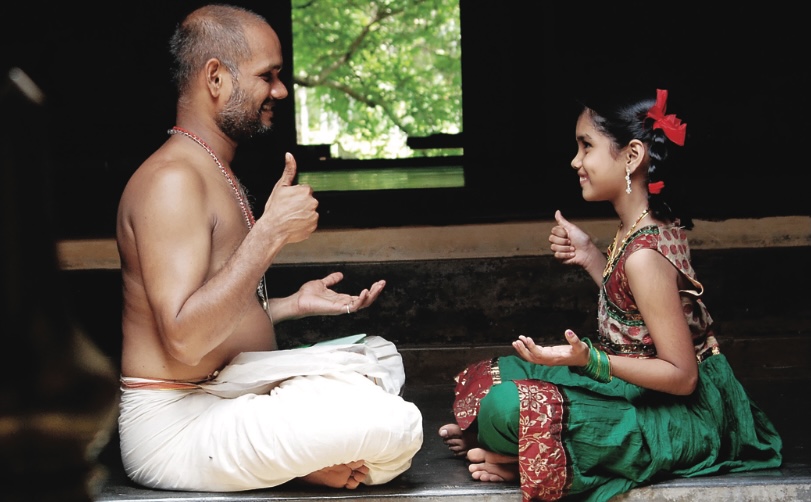BY G.K. NAIR
Ever since Jyothsna can remember, she’s been hearing verses from the Thantra scriptures of Kerala. This divine opportunity has come to her because she was born into an old and traditional Thantri family. For generations, its members have provided priests to a number of major and minor temples in the state, including the famous Sri Padmanabhaswamy Temple of Thiruvananthapuram, which is still controlled by the erstwhile royal family of Travancore.
Thus, she grew up in a religious and spiritual ambiance, daily listening to the Vedic and Thantric mantras. But, unlike other children, this little girl paid close attention, and by a young age was reciting some by heart. Her grandfather, Thantri Padmanabhan Namboothiripad, recognized her unusual talents and set out a course of training for her. In the early hours of each day, before school, she studied mantras, rites and rituals. She was initiated to Thantra in 2008, at the age of ten.
With her grandfather’s blessings, she installed and consecrated the murti of Devi Bhadrakali on May 23, 2010, in the sanctum sanctorum in the Painkunnikavu Temple in Irinjalakuda in Kerala’s Thrissur district. There are a few other Thantri priestess in Kerala, but this was the first time in known history that a consecration had been performed by one so young.
Jyothsna’s mother, Archana Antharjanam, told Hinduism Today, “We don’t want it to be construed as part of any women’s liberation movement or any such agenda. It is not a revolutionary act. We brahmin women have always performed pujas in our own homes.”
Jyothsna’s parents, grandparents and all her classmates were among the large number of devotees attending the installation. Devotees received the blessed prasadam, food offering made to the Diety, from Jyothsna and offered her dakshina, a monetary gift, in return. Her 7th grade teacher said she was proud to have a “young girl Thantri” in her class and the school.
Jyothsna explained to Hinduism Today, “I developed a liking for doing puja and reciting the Sanskrit mantras from watching my father and grandfather. I don’t know why, but I love worshiping Devi Bhadrakali.” She said she would pursue further study, but could not say if she would take it up as a profession. “I have not learned it with that end in mind.”
There has been little criticism of her initiation and performance of the installation from the Thantri community, especially as her grandfather is one of Kerala’s most revered Thantri priests. He defends the initiation, saying, “The womanhood of God and the glorification of women is the core of Thantra,” and in accordance with the scriptures of Kashmir Saivism followed here. According to the tradition, he explained, ten human births are believed to be needed for one to become a Thantri, and the girl must have done something great in her previous life.
As to qualifications, he said, “Anybody who is inclined from birth can study with devotion and become a Thantri, irrespective of caste or gender. Women often have more commitment to the required sadhanas, and understand that Thantra is not only for doing puja, but for obtaining Self Realization.” He pointed out that there were women priests in ancient India and that today the Kerala woman saint, Mata Amritanandamayi Devi, has installed Deities in many temples of her ashrams. “There are no hard and fast rules on this subject,” he concluded.
Some of the devotees and officials from the Travancore Devaswom Board, which administers some 1,200 temples in the area, were not very happy with women becoming Thantris. According to Mr. Jagan Mohan Das a former Devaswom Board Commissioner, there is a general perception in the minds of the devotees that a Thantri should be a mature male capable both in spiritualism and in thantra. “Therefore, we cannot think of having a young boy or girl performing the role of a Thantri in a temple,” he said.
Brahmasri Kandaru Rajivuru, Thantri of the famous Sabarimala Temple, countered that women can also perform the Thantric rituals as it is not forbidden for them in any of the scriptures. Jyothsna’s initition does not represent a social reform. But, he said, it would be up to her to decide whether to take it on as a vocation, and also depend on her responsibilities after marriage. He pointed out, “It is no longer a profession which can sustain a family. In 95% of cases, priests are low paid, the same as any of the temple hired help. In other religions, priests enjoy a respectable position. The result is that the present generation does not want to take up this traditional profession. Even though my children are learning it, their interest is in lucrative professional jobs outside this sphere. You cannot blame them.” PIpi
